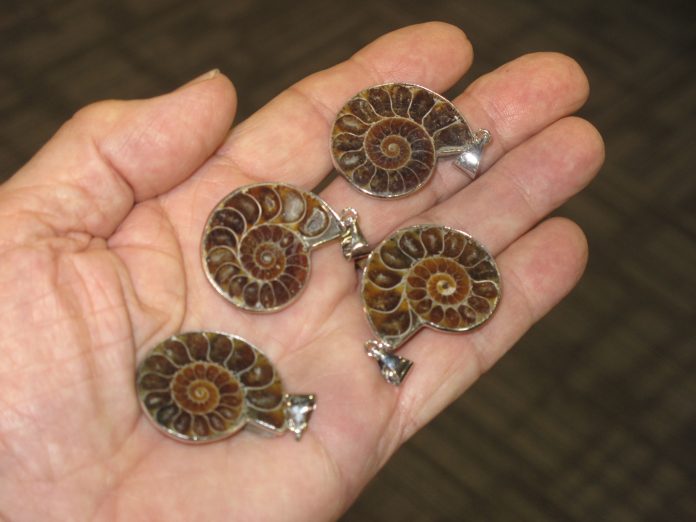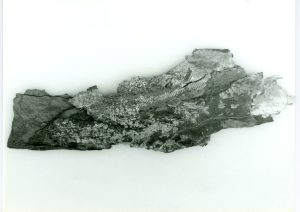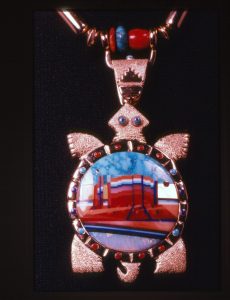
Beach fossils make up a large segment of museum displays, shows and private collections. I have been able to learn about fossils and have seen some of the most unusual and rare fossils. For instance, have you ever seen a dinosaur bone with an interior filled with gorgeous and very colorful fortification agate?
Silverfish
Fossil fish specimens are popular. The hard parts of the fish are replaced by silica or common minerals. Germany has yielded an amazing series of fish fossils in shale. One such fossil I handled and photographed is a fish on shale but instead of a normal silica replacement, the hard parts were replaced by native silver. A very rare fossil!
Shale is just one of the rocks that can yield fossils. This is because shale starts as mud at the bottom of lakes, rivers and oceans. As mud, sand and debris are carried onto a body of water, the solid material settles to the bottom. There the remains of ancient creatures are slowly covered by more mud. Very slowly as the remains decay, minerals dissolved in the water may replace the hard parts resulting in mineral fossils.

Pyritized Beach Fossils
In ideal and unusual circumstances the mud and waters are rich enough in iron and sulfur to form iron pyrite which replaces the hard parts and often fills the interiors of dead sea life.
Snail, trilobite and especially ammonite shells can be replaced by pyrite. They come in all sizes and when polished are particularly attractive when in a ring or pendant. Here in the United States, pyritized fossils are found in Ohio and the Dakotas. This is because the North American continent was, at one time, inundated by ocean waters for millions of years. During this time, layer after layer of limey mud formed which today makes up the limestone formations that yield nice fossils.
Parts of Ohio are well known for yielding fossils that are pyritized. Ammonites are particularly common and are sought by collectors. Germany is well known for its pyritized fossils of ammonite, bivalves and snails. These are showy and eagerly collected.
Beach Fossils from the White Cliffs of Dover
Other good rock sources for fossils are sandstone and limestone. These deposits can be many meters thick. Look at the well-known White Cliffs of Dover, England. They are very thick and hold some amazing plesiosaur fossils. These fossils were discovered when a young girl named Mary Anning was walking on the beach and observed a lot of bones in the chalk. Amazing to be walking along a beach and find an ancient fossil like Mary did! Her fossil now hangs in the Museum of Natural History in London.

Red Coral
As a science teacher, I had a very nice rock, mineral and fossil collection in my classroom. In those days, I also had a group of students who would join me on weekends to go out and collect minerals. To interest kids in the collection, I described some of the unusual rocks for them.
One specimen in my classroom collection was coral, an artistic cluster of delicate calcium carbonate which forms on the ocean floor. Most coral is quite delicate but some is hard enough for lapidary artists and is used in jewelry. Here in Arizona, Native American artists now incorporate a wide range of very colorful gem minerals in their work including lapis, charoite, precious opal, suglilite and red coral which contrasts so nicely with other gems.
Local artist Jessie Monoongye, whose work is featured in museums, creates marvelous jewelry and red coral is one of his favorite gemstones.
Red coral is rare and hard to get and harvesting it in many places is now controlled or forbidden. Hawaii, for example, forbids collecting coral within 1000 miles of the islands.
Beach Fossils: Tampa Bay Coral
Of the corals, my favorite is Tampa Bay coral, a very special kind of coral that is found primarily in the bottom of Tampa Bay, Florida. It has been replaced by silica quartz so it is perfect for the lapidary. It forms deep in the Bay floor mud.
When it was decided to dredge the Bay to make it a deep-water port, the floor mud was piled on the shore and the local rockhounds had a field day. Tampa Bay coral was available in huge quantities. You might say it took the lapidary hobby by storm. Rockhounds from up north who wintered in Florida worked the muck piles to get the coral. Tampa Bay coral was exhibited at major shows and was sold by dealers who specialized in the Tampa Bay corals.
Dredging has deepened the Bay so it stopped and the supply of fossilized coral has slowed to a trickle. Today good specimens appear only when there is intermittent dredging to keep the channels open.
This story about beach fossils previously appeared in Rock & Gem magazine. Click here to subscribe. Story by Bob Jones.














